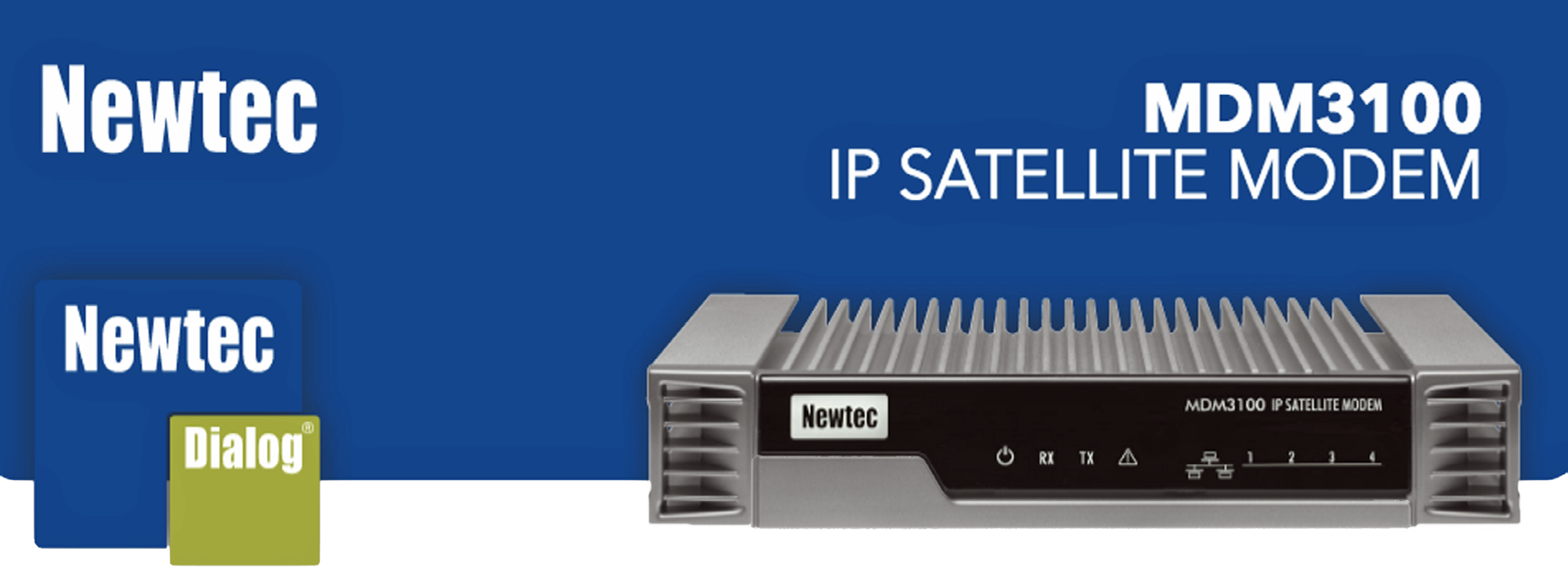Despite the number of articles and industry blogs that have already been dedicated to interference mitigation concerning satellite communications, there still does not seem to be enough clarity on what measures have already been taken and what solutions are in the pipeline.

Different SATCOM markets are at a different level of interference mitigation technology implementation, mainly due to the nature of their operations. The commercial SATCOM markets, more specifically the video broadcast operators, have taken the first steps into interference reduction mitigation by implementing the DVB Carrier ID (DVB-CID) standard. VSAT systems, such as the Newtec Dialog® multiservice platform, have also implemented the technology to reduce interference incidents.
In this article, the focus will be on the need for interference technology for the government and defense market. Compared to the commercial SATCOM markets, some extra measures need to be considered in order to safeguard the identity of the uplinking terminals and ensure the efficiency of operations is not interfered with.
Root Causes Of Satellite Interference
Interference of a satellite communication signal in the government and defense domain can seriously endanger an operation or slow down daily activities. As such, understanding the root causes of a satellite interference incident is half the work.
As well as the intentional jamming of the signal, there are various other root causes that could create satellite communication link interference. When questioning main satellite operators, the following conclusions are derived.
The main categories of satellite interference are due to Adjacent Satellite Interference (ASI) (13 percent), Co-Polarization (54 percent) and Cross-Polarization (30 percent). This number of ASI incidents is expected to increase over time, due to the rise of on-the-move and on-the-pause SATCOM platforms. These applications typically require small antennas and incorrectly pointed rather easily.
Within the Co-Polarization category, there are several subcategories of incidents that result in interference. The vast majority of reasons for interference here are due to setting up unauthorized carriers without checking with the proper authorities, the frequency plan or the transmission schedule. Other subcategories of interference can be cataloged as sweepers, spectral regrowth, retransmission of GSM/TV/Radio signals, intermodulation, saturation and uplink noise.
Carrier ID As A First Weapon Against Interference
Initiated by the commercial SATCOM community, today, quite a number of SCPC satellite links with a carrier ID embedded in the transmission path are already being seen. Much credit has to go to the Interference Reduction Group (satirg.org) which has been pushing for CID standards to fight interference for several years.
In fact, the majority of COTS SCPC modulators and modems manufacturers have implemented the DVB-CID standard on their new equipment. At Newtec, Carrier ID has been on board ever since 2014 with the Newtec 6000-platform DVB-S2/S2X modems and modulators.
The Newtec modulator or modem will typically inject the DVB-CID identifier into the carrier. The identifier contains mandatory information, such as a 64-bit MAC address and a vendor serial number, in combination with optional user configurable data such as GPS coordinates, the carrier name and user contact coordinates. This information is injected into the carrier by the modulator at the uplink site.
In order to lower the impact on the throughput over the satellite, the Carrier ID information is spread below the noise floor of the carrier. At the satellite operator facilities, special measurement receivers are installed. Upon any occurrence of interference, these receivers can read out the contact information from the carrier and quickly point out the source of interference.

Having an implemented Carrier ID embedded in the transmission today provides immediate benefits, such as the rapid identification of the interfering carriers, fast action to resolve the incident and the offer of improved Quality of Service (QoS) for end-users. Still, a lot of work needs to be done to adapt the Carrier ID toward the reality of government and defense SATCOM operations. Furthermore, Carrier ID today is only implemented for video and data SCPC links; VSAT networks also need to be considered.
Adapting Carrier ID: Government + Defense Reality
Government and defense agencies nowadays are reluctant to implement the current DVB-ID standard in their satellite communication networks due to security considerations. On the one hand, they do not want to give away the identity of a satellite link as such might be used for mission critical communications and targeted for jamming. On the other hand, not having Carrier ID could make the link suspicious, as all other SATCOM links would have an ID.
The solution, as voiced through the Interference Reduction Group and their SATCOM industry members, would be to maintain the Carrier ID inside the satellite transmissions but, at the same time, assure anonymity.
First, the Carrier ID will only have a unique identifier and the name of the owning satellite operator. No other information is required.
Secondly, the procedure to identify the ID can be adapted, separating commercial ID databases from government and defense ID databases. In the event of an interference incident, the interfering carrier’s ID can first be checked against the commercial database by the satellite operators and, if there is no match, be passed on to the government and defense agency through a secure channel to check the ID via their own CID monitoring and database systems.
What About VSAT Networks?
Having a Carrier ID process adopted for government and defense SCPC or MCPC links only resolves some interference incidents. Obviously, also needed for consideration are VSAT networks, as they represent the majority of the network infrastructure in the government and defense domain.
Three main issues arise with VSAT installations:
• The quality of the equipment, which varies depending on the VSAT system manufacturer or the age of the VSAT installation
• VSAT terminals are increasingly installed on platforms that are on-the-move (land/sea/air) or on-the-pause using small or phased array antennas, which might cause adjacent satellite interference
• There is a lack of training of people involved in humanitarian or military operations to properly install and operate VSAT systems
Mitigating interference incidents caused by VSAT networks will only be possible by deploying a well-designed VSAT system that can proactively highlight problems combined with additional tools in case the system fails and operated by trained personnel.
Newtec Dialog Multiservice VSAT Platform Interference Mitigation
When Newtec designed the Newtec Dialog VSAT platform, some important measures were taken to reduce the interference risk. The Newtec Dialog platform is a scalable, flexible and efficient multiservice satellite communications platform that allows government and defense operators, as well as satellite service providers, to adapt their network easily to their operational requirements.
1. The operator has the flexibility to select the technology, equipment and type of services that match the operations and the applications they wish to address. The efficiency is defined both at operational and technology level in the Newtec Dialog platform.
2. The operator can easily optimize modulation and bandwidth allocation, while guaranteeing the highest efficiency and availability. In order to meet the high availability and QoS requirements in government and defense networks, the following measures were taken into account when the Newtec Dialog platform was designed to reduce interference incidents.
3. Carrier ID: The forward DVB-S2X link inside the Newtec Dialog VSAT platform from the hub towards the remotes has an embedded Carrier ID. Combined with the Integrated Management System and Newtec Satlink Manager technology, some DVB-S2/S2X return links using MDM6000 remotes could also use DVB-CID.
4. Carrier Locking Mechanism: The Newtec VSAT platform has a carrier locking system on board which basically means that the remote modem/terminal will not transmit if it does not read the correct information from the forward link.
5. The Cross-Polarization Management: Located inside the Newtec platform, this allows an operator to measure interference from individual terminals and react in a proactive and automated way. Basically all remote modems inside a satellite network are known by the Newtec Dialog Network Management Station (NMS) through their MAC addresses. The Terminal Certification Management System inside the NMS uses the cross-pol measurement data in order to verify the alignment of the polarization angle.
If a terminal in the network goes beyond the determined nominal value and starts to create interference the NMS will flag the incident, an alarm will be set and the interfering VSAT will be proactively shut down. These proactive monitoring and measurements are automated and can be scheduled individually or by policies. A VSAT system can react quicker than a person to detect interference and shut down a terminal causing problems.
6. Automated Terminal Uplink Power Control: We frequently see satellite links without automated link power control causing interference. When the link quality is degraded by weather conditions or by bad pointing an operator might wrongly crank up the power to increase the link performance. By increasing the power too much the satellite link will create interference. The Newtec Dialog VSAT platform uses Mx-DMA™ (Cross-Dimensional Multiple Access) technology for the return links.
The Mx-DMA return technology automatically and continuously adjusts the frequency plan, the symbol rate, the modulation, coding and power in real-time for every terminal in the satellite network. As such, the modem controls the terminal power value and the entire system adjusts every single second based on return traffic demand, the network QoS management and channel conditions for the terminal population in the network.
In more detail, the Mx-DMA controller distinguishes uplink fades from downlink fades. As such, remote power levels will only be increased in the event of an uplink fade (and not a HUB-side fade). By automating the process for all terminals in the network the Newtec Dialog VSAT return link will not create interference.
7. Interference Measuring: An extra benefit of the Newtec Mx-DMA technology is the fact the Newtec VSAT system is capable of measuring the interference. With these measurements the necessary actions can be undertaken.
8. Point & Play: One of the main reasons for interference is the bad pointing by unskilled satellite VSAT installers and operators. In government and defense crisis management operations it is up to the deployed people (with basic IT skills) to install the VSATs due to budget constraints and lack of personnel. This can only be avoided by providing them with a easy-to-use tool to facilitate the installation process as well as by training.
The Point & Play tool provided with the Newtec Dialog VSAT terminals allows the installer (be it a professional installer or the end-user) to easily position the antenna correctly by identifying the satellite and providing feedback on both signal quality and lock. Once the VSAT terminal is in lock it will be auto-commissioned by the Newtec Dialog hub and monitoring can start.
9. Training: In addition to a pointing tool, good training on the VSAT system is fundamental. With training, a lot problems can already be solved. The training should not only focus on installation. At Newtec we will also educate the customer on how to configure the system (understanding the basics of satellite, how to follow a set-up procedure and configure a network). Furthermore, the training will include component selection (not every BUC matches every modem or antenna) and the best locations to set-up a VSAT (for example, not next to GSM beacon). At the end of the training, different certifications can be reached depending on the level of training and the function of the trainee.
Type Approval For VSAT Systems + SATCOM Equipment
Having Carrier ID and the other above-mentioned measures are the first steps toward avoiding or resolving the majority of interference incidents with VSAT networks. A next step would be to create a quality assurance label by an internationally recognized and independent SATCOM organization.
Today, many operators will source different SATCOM components from different vendors, buy new modems but keep the older RF infrastructure or source cheap unreliable RF equipment to reduce CAPEX costs. These are typical disaster scenarios towards new interference incidents.
The international certification organization would need to test, approve and recommend different VSAT combinations. The outdoor equipment (BUC, cable and antenna) would need to be tested and approved in combination with the modem in order to achieve the best results. Which organization will run the initiative and provide the quality label is still an uncertain element within the satellite industry.
The War On Interference
Interference incidents can cause serious problems within government and defense SATCOM networks. They endanger the operational efficiency and slow down daily activities.
Industry standards such as DVB-CID and well-designed VSAT systems with embedded interference-mitigating technology, such as the Newtec Dialog Multiservice VSAT platform, are already reducing a big number of incidents. Proactive and reactive measures are key in large-scale VSAT networks to drastically reduce interference. A VSAT system can react quicker than a person to detect interference and shut down a terminal causing problems.
Having an international independent instance that will issue quality labels to ODU-modems combinations could be an extra weapon in the war
on interference.
newtec.eu

Koen Willems started his career in 1998 with Lernout&Hauspie as a project manager in the Consulting & Services division. More recently, he joined Toshiba as a Product Marketing Manager for the Benelux and, later, for the European market. In a total of 6 years, Koen contributed to all of the major Toshiba Retail IT product releases.
Mr. Willems is, currently the Market Director for Government and Defnese for Newtec, a Belgium-based specialist in satellite communications. Koen holds a degree in Germanic Languages (University Ghent, Belgium, 1997) and completed a Masters degree in Marketing Management program at the Vlekho Business School in Brussels (1998). He acquires a Six Sigma Black Belt for product development and process improvement in 2006.
Koen is also a Senior Contributor to MilsatMagazine.


